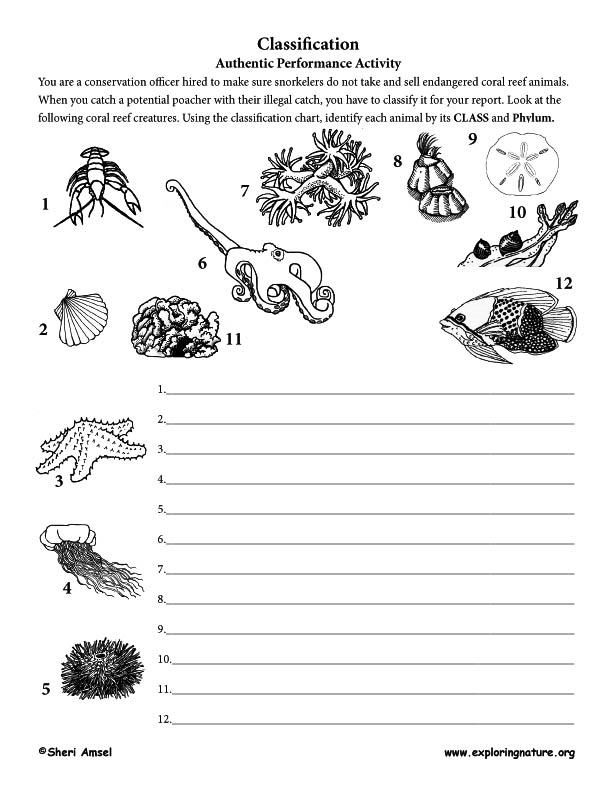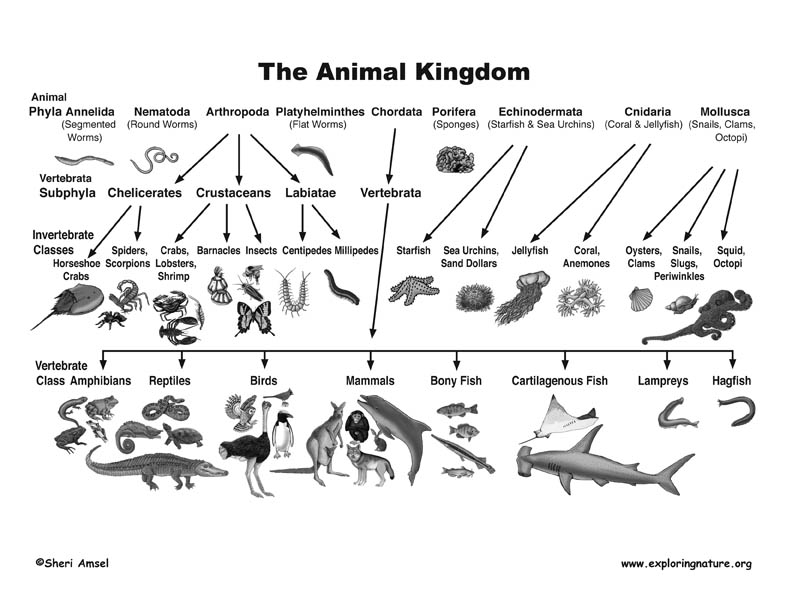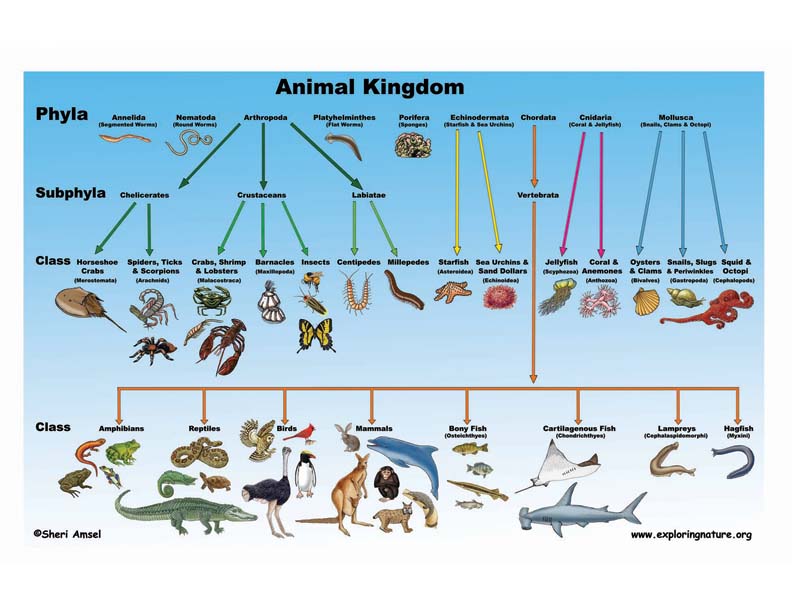

Authentic Performance Activities facilitate a student's understanding of a lesson's usefulness in real life. They are also an Understanding by Design (UbD) assessment tool. Focus questions act as pre- and post-assessment indicators of the activity's effectiveness.
Focus Questions:
1. Why do we learn about the classification of animals?
2. Does knowing which animals are grouped together help you understand those animals a little better?
3. How can knowing the classification of animals help the environment, society, tourism, our ability to get a job?
4. Is there a connection between this "job" and preserving biodiversity of species?
You are a conservation officer hired to make sure snorkelers do not take and sell endangered coral reef animals. When you catch a potential poacher with their illegal catch, you have to classify it for your report. Look at the following coral reef creatures. Using the classification chart below, identify each animal by its Class and Phylum.
As a follow up activity, make a poster warning against collection and identifying coral reef species that might be found while snorkeling. Use the Animals by Classification Index to identify species for your poster.
New Generation of Science Standards (NGSS) - Middle School Life Science
Disciplinary Core Ideas
LS2.A: Interdependent Relationships in Ecosystems
• Organisms, and populations of organisms, are dependent on their environmental interactions both with other living things and with nonliving factors. (MS-LS2-1)
• In any ecosystem, organisms and populations with similar requirements for food, water, oxygen, or other resources may compete with each other for limited resources, access to which consequently constrains their growth and reproduction. (MS-LS2-1)
• Growth of organisms and population increases are limited by access to resources. (MS-LS2-1)
• Similarly, predatory interactions may reduce the number of organisms or eliminate whole populations of organisms. Mutually beneficial interactions, in contrast, may become so interdependent that each organism requires the other for survival. Although the species involved in these competitive, predatory, and mutually beneficial interactions vary across ecosystems, the patterns of interactions of organisms with their environments, both living and nonliving, are shared. (MS-LS2-2)
LS2.C: Ecosystem Dynamics, Functioning, and Resilience
• Ecosystems are dynamic in nature; their characteristics can vary over time. Disruptions to any physical or biological component of an ecosystem can lead to shifts in all its populations. (MS-LS2-4)
• Biodiversity describes the variety of species found in Earth’s terrestrial and oceanic ecosystems. The completeness or integrity of an ecosystem’s biodiversity is often used as a measure of its health. (MS-LS2-5)
LS4.D: Biodiversity and Humans
• Changes in biodiversity can influence humans’ resources, such as food, energy, and medicines, as well as ecosystem services that humans rely on—for example, water purification and recycling. (secondary to MS-LS2-5)
Science and Engineering Practices (NGSS)
Developing and Using Models
Modeling in 6–8 builds on K–5 experiences and progresses to developing, using, and revising models to describe, test, and predict more abstract phenomena and design systems.
• Develop and use a model to describe phenomena. (MS-LS2-3)
Constructing Explanations and Designing Solutions
Constructing explanations and designing solutions in 6–8 builds on K–5 experiences and progresses to include constructing explanations and designing solutions supported by multiple sources of evidence consistent with scientific ideas, principles, and theories.
• Construct an explanation that includes qualitative or quantitative relationships between variables that predict phenomena. (MS-LS2-2)
Crosscutting Concepts (NGSS)
Patterns
• Patterns can be used to identify cause and effect relationships. (MS-LS2-2)
Cause and Effect
• Cause and effect relationships may be used to predict phenomena in natural systems. (MS-LS1-8)
• Phenomena may have more than one cause, and some cause and effect relationships in systems can only be described using probability. (MS-LS1-4),(MS-LS1-5)
Performance Expectations
Students who demonstrate understanding can:
MS-LS2-5. Evaluate competing design solutions for maintaining biodiversity and ecosystem services.* [Clarification Statement: Examples of ecosystem services could include water purification, nutrient recycling, and prevention of soil erosion. Examples of design solution constraints could include scientific, economic, and social considerations.]
When you research information you must cite the reference. Citing for websites is different from citing from books, magazines and periodicals. The style of citing shown here is from the MLA Style Citations (Modern Language Association).
When citing a WEBSITE the general format is as follows.
Author Last Name, First Name(s). "Title: Subtitle of Part of Web Page, if appropriate." Title: Subtitle: Section of Page if appropriate. Sponsoring/Publishing Agency, If Given. Additional significant descriptive information. Date of Electronic Publication or other Date, such as Last Updated. Day Month Year of access < URL >.
Amsel, Sheri. "Classification - Authentic Performance Activity" Exploring Nature Educational Resource ©2005-2024. December 14, 2024
< http://www.exploringnature.org/db/view/Classification-Authentic-Performance-Activity >



